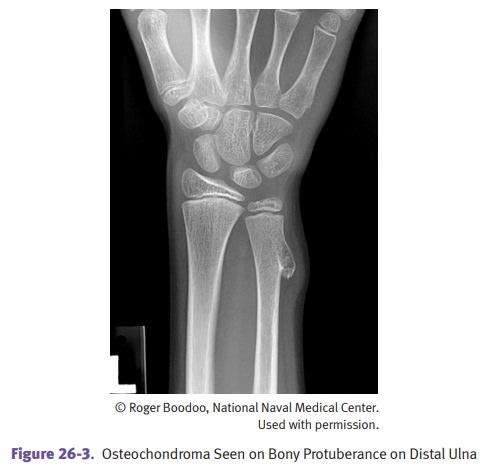Chapter: Pathology: Bone Pathology
Benign Tumors of Bone
BENIGN TUMORS OF BONE
Osteoma is a benign neoplasm that frequently involves
the skull and facial bones. Osteoma can be associated
with Gardner syndrome. Malignant transformation doesn’t occur.
Osteoid osteoma is a benign, painful growth
of the diaphysis of a long bone, often the tibia or femur. Males are
affected more than females, with peak age 5–25. Pain tends to be worse at night
and relieved by aspirin. X-rays show central radiolucency surrounded by a
sclerotic rim. Microscopically, ostoblasts line randomly connected trabeculae.
Osteoblastoma is similar to an osteoid
osteoma but larger (>2 cm) and often involves vertebrae.
Osteochondroma (exostosis) is a benign bony
metaphyseal growth capped with car-tilage, which originates from epiphyseal
growth plate. It typically presents in ado-lescent males who have firm,
solitary growths at the ends of long bones. It may be asymptomatic, cause pain,
produce deformity, or undergo malignant transformation (rare). Osteochondromatosis (multiple hereditary
exostoses) produces multiple, often symmetric, osteochondromas. Excision is
usually curative.

Enchondroma is a benign cartilaginous growth within the
medullary cavity of bone, usually involving the hands
and feet. It is typically solitary, asymptomatic, and requires no treatment.
Multiple enchondromas (enchondromatosis)
can occur as part of both Ollier disease (multiple and unilateral) and Maffucci
syndrome (with hemangiomas), and carry a risk of malignant transformation.
Giant cell tumor of bone (“osteoclastoma”) is a benign
neoplasm containing multi-nucleated giant cells admixed with stromal cells. It
is uncommon but occurs more often in females than in males, with peak age
20–50. Clinically, the tumor produces a bulky mass with pain and fractures.
X-rays show an expanding lytic lesion sur-rounded by a thin rim of bone, with a
possible “soap bubble” appearance. Treatment is surgery (curettage or en bloc resection). Osteoclastoma is
locally aggressive with a high rate of recurrence (40–60%). In spite of being
considered benign, approximately 2% will metastasize to the lungs.
Grossly, the tumor causes a
red-brown mass with cystic degeneration that often involves the epiphyses of
long bones, usually around the knee (distal femur and proximal tibia).
Microscopically, multiple osteoclast-like giant cells are distributed within a
background of mononuclear stromal cells.
Related Topics